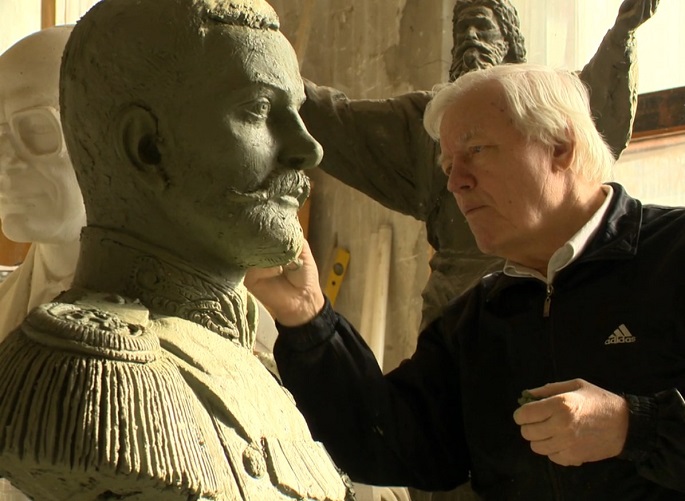China and Russia’s relationship go beyond advancing mutually beneficial development agenda and establishing strategic partnership. They also open their doors to each other for cultural exchanges.
One person responsible for connecting the most populous nation to the world’s largest country via art would have turned 80 on Dec. 16.
Russian sculptor-painter-teacher Albert Charkin, however, died a septuagenarian on the morning of Jan. 9, reported various Russian news sites.
In an interview with Xinhua, Shao Changchun said his “open-hearted” artist friend created an “art bridge” for Sino-Russian relations, according to the Global Times.
The director general of Peace Tour Cultural Exchange Center, a nongovernmental organization in Beijing, worked together with Charkin in 2004 for a Chinese-Russian cultural event. They held it at I. Repin Institute, where Charkin was concurrently a rector and professor.
Shao said that it was their first meeting, and the support Charkin rendered brought “great success” to the event.
His support continued long after the said event.
Every time Peace Tour engaged in Sino-Russia cultural exchanges in Russia, the group would experience Charkin’s support conveyed through his “friendliness and large-heartedness,” recalled Shao during the interview.
“His personal qualities helped greatly . . .”
The lengthy post by the administrator of the official Facebook page of the Stockholm Culture Awards--Charkin was a recipient--echoes similar sentiments.
Posted on Jan. 11, part of the message reads: “He was a very friendly and helping person. A true friend.”
The post concludes with: “The Stockholm Culture Award Association honors Albert with a moment of silence.”
Charkin, the Petersburger
Born in 1937 in the town of Belyov in Tula Oblast, Charkin said in a 2014 interview with spu.kp.ru correspondent Elena Livesey, that he spent 50 years of his life living in St. Petersburg and “could not imagine life” without it.
Georgy Poltavchenko, the incumbent governor of St. Petersburg, described the People’s Artist of the Russian Federation--the highest honorary title given to outstanding artists--as “a rare natural talent,” according to spb.kp.ru.
“Albert Serafimovich Charkin [is] no longer with us, but his memory will forever remain in our hearts, in his works and the works of his pupils,” said Poltavchenko.
Aside from being the rector of and teaching at the I. Repin St. Petersburg State Academy Institute of Painting, Sculpture and Architecture or simply I. Repin Institute, named after the 19th-century Russian realist painter Ilya Repin, Charkin likewise served as the president of the Artists Trade Union of Russia and chairman of St. Petersburg Union of Artists.
Beyond his accomplishments as a leader and teacher, people would particularly remember Charkin for what he was inarguably best at: being an artist.
As a sculptor, he immortalized these prominent Russian figures: Tsar Peter I aka Peter the Great (1672-1725), Grand Duke Alexander Mikhailovich (1866-1933) and the poet Sergei Yesenin (1895-1925).
The bust of Peter the Great occupies a conspicuous space at the main hall of the Moscow Railway Station. The bronze bust of Grand Duke Alexander Mikhailovich takes shelter at St. Petersburg River Yacht Club in Krestovsky Island. The Monument to Sergei Yesenin stands at the Tauride Garden in St. Petersburg.
For Charkin, Russia’s second biggest city acts like a window into the world of culture and into the world at large.
Peeking into the Window
“Art is one of the best means of exchange available to Russia and China,” according to Charkin.
Several Chinese artists studied at the Russian Academy of Arts in St. Petersburg, whose building houses the I. Repin Institute.
The academy each elected as Honorary Member the Chinese artists Zhou Zhihui (2009), Liu Ming Xu (2010) and Yang Xiaoyang (2014).
Yang, the president of Beijing-based China National Academy of Painting and who presented a Silk Road exhibit at the National Art Museum of China in 2016, also taught as a professor at the Russian Academy of Arts.
According to Shao, other Chinese artists whom the academy appointed as professors include Liu Guohui, a Guohua--traditional Chinese painting--painter, graphic artist and figure painting expert; Wang Zhong, the vice director of the Theory Committee of the Chinese Artists Association; and painter Zheng Yi.
Chinese artists, art enthusiasts and the public in general saw right before their eyes some of the works of Charkin when he participated in the First and Second Beijing International Art Biennale in 2003 and 2005.
For those in China who missed Charkin’s exhibits, they can still see one of his creations: the statue of a mother carrying her newborn child called “The Morning of Life” in Changchun, Jilin Province.
Shao said that the government of China wanted to award the Silk Road Humanitarian Cooperation Prize--the second highest among the three Silk Awards (the Peace Prize being the highest and the third one, the Outstanding Diplomacy Prize)--to Charkin for his invaluable support to Sino-Russia cultural exchanges.
The Silk Awards, first given in 2014, has a regulation requiring a recipient to personally accept the award.
Citing health issues, according to Shao, Charkin failed to grace the awarding ceremony in Beijing.
“That’s why we lost a precious opportunity to express our gratitude to him,” said Shao, as quoted by the Global Times.
Charkin once lightly said: “Work until you fall asleep!”
After what seems to be half a century of working, he now fell into an eternal slumber, but the tangible and intangible legacies of Albert Serafimovich Charkin shall live on both in his motherland of Russia and, some 2,853 km. away, in China.



























